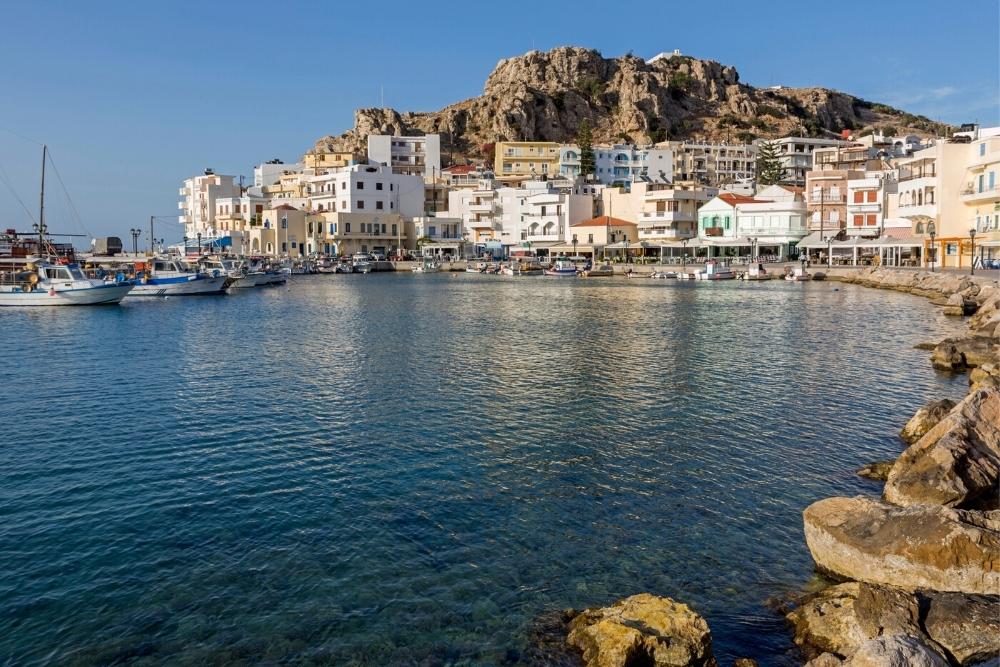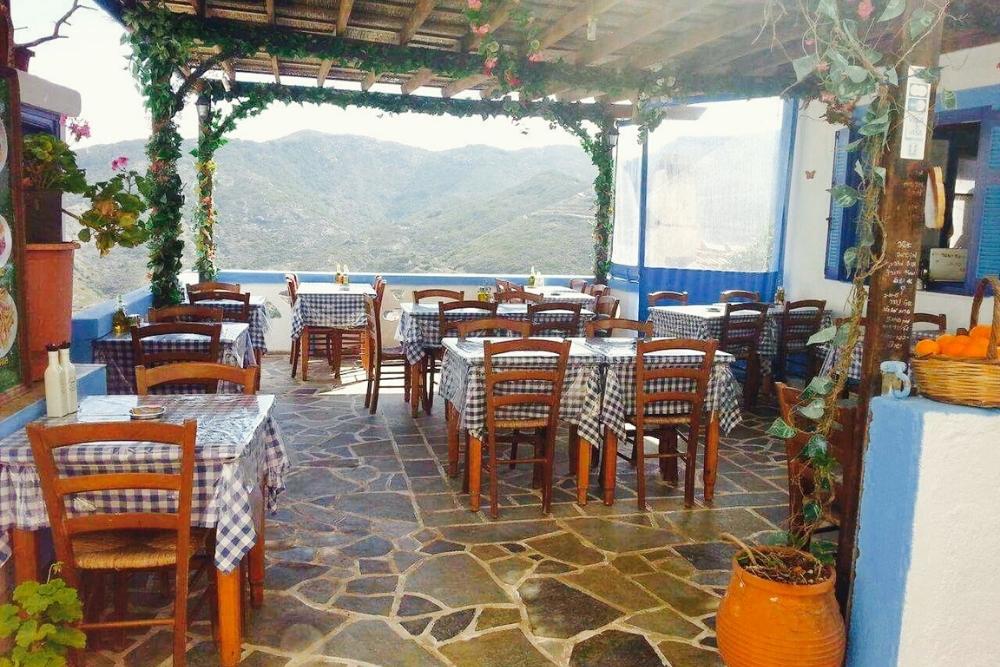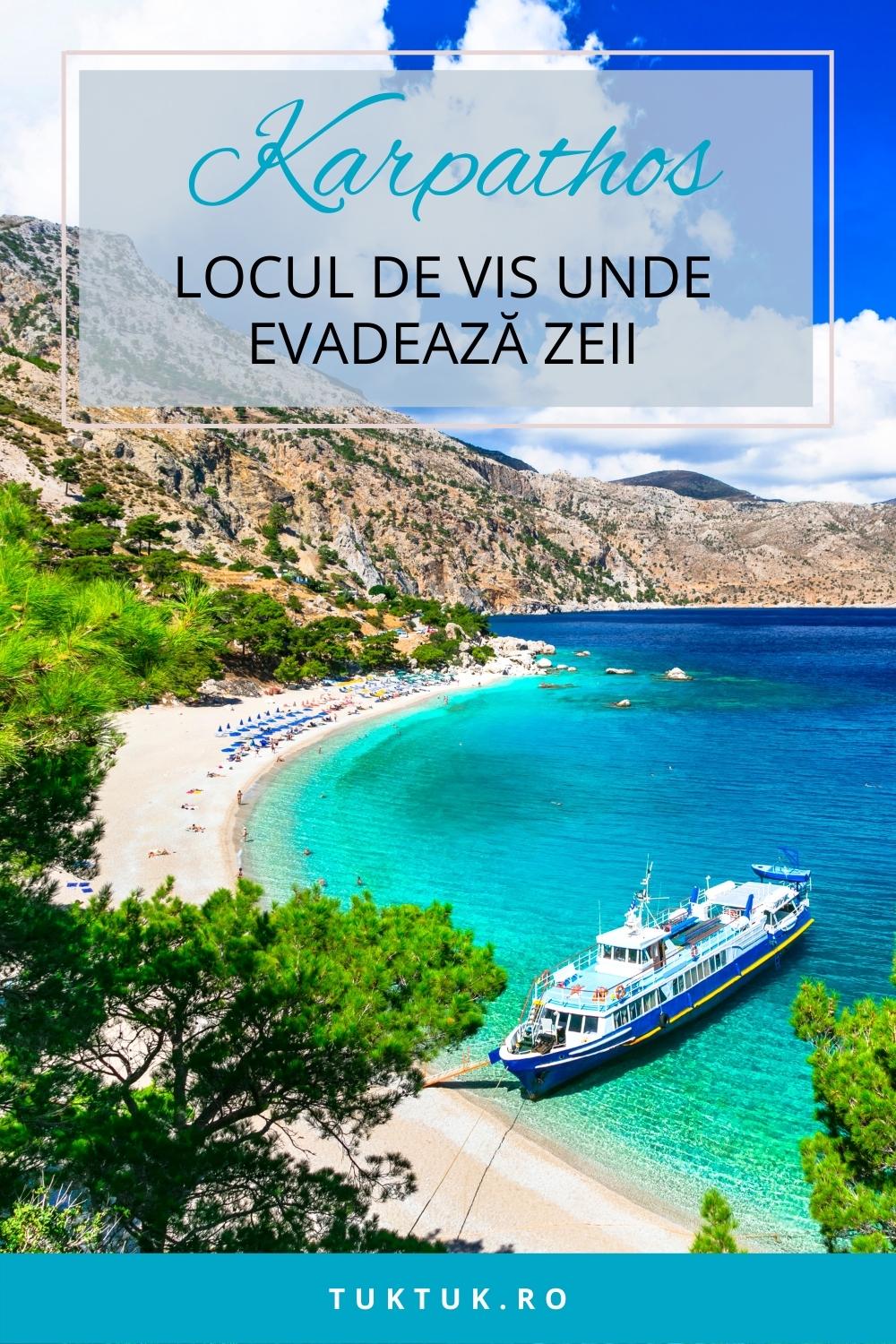Somewhere in the Aegean Sea, between Crete and Rhodos, part of the Dodecanese archipelago, lies the Karpathos Island. With a population of around 7000, which can increase in summer by 3-4 times due to the return home of former locals, plus growing numbers of tourists, Karpathos is the second-largest island of this southern Aegean archipelago.
High mountains (maximum altitude Kali Limni – 1215 m), picture-postcard scenery, traditional villages, turquoise beaches, and a rich history are the elements that briefly characterize Karpathos. But in the general characterization, one cannot forget the locals, who know how to enjoy life, honoring their traditions and organizing beautiful festivals throughout the year.
- What to do and see on Karpathos island
- Map with main tourist attractions in Karpathos Island (zoom for details)
- Pigadia, the Karpathos island capital
- Olympos Village
- Saria Island
- Menetes village
- Poseidon’s Cave
- Other villages in Karpathos
- Festivals in Karpathos
- Beaches of Karpathos
- Best hotels in Karpathos
- Best restaurants in Karpathos
- How to get to Karpathos Island
- Pin it!
There are 12 villages on the island of Karpathos, some in the mountains, others near the sea, all marked by remarkable hospitality, where family-run tavernas are ready to offer visitors delicious local dishes. Christian and Byzantine churches dot the island, and tourists are drawn to landscapes that vary from region to region.

Karpathos’ history is rooted in mythology. According to legend, pirates here loved their homeland so much that they went to Mount Olympus to kidnap the gods and bring them to Karpathos. Their plan succeeded, and the ‘victims’ were taken to a mountain village called Olympos, which still exists today.
We don’t know whether the gods remained in Karpathos or not, but it is known that this island is one of the least commercials of the Greek islands. A quick drive through some of the villages transports you back in time, the overall impression being that you are in a place of contrasts. Mainly – or mainly – generated by the two predominant landforms: mountain and sea. In fact, the island’s history is marked to a large extent by the pirates’ deeds, as its personality has been defined more by its mountainous structure.
What to do and see on Karpathos island
With so many contrasts in front of you – from rugged mountains to serene beaches – the holiday opportunities unfold without much difficulty. Of course, Karpathos is an island for those who love nature and sporting activities. For example, the south-eastern part of the island is haunted by constant winds, making the Afiartis area a sought-after spot for surfers and kite surfers.

The north is a protected area, with Saria and Astakidonisia internationally recognized for their biodiversity. Karpathos is also an important stopover for migratory birds on their way from Africa to Europe. It has almost 480 km of hiking trails, ten of which are specially dedicated to birdwatchers.
All in all, Karpathos is not a crowded island, with tourists trampling over each other and crowding the beaches, as on other, more famous islands. Karpathos is relatively new to the tourist circuit and still boasts an almost unnatural quiet in summer. Here’s what you can do and see in Karpathos:
Map with main tourist attractions in Karpathos Island (zoom for details)
Pigadia, the Karpathos island capital

Pigadia is the capital of Karpathos. It is built on the site of one of the ancient towns here, Poseidio (or Posi), which worshipped Poseidon, the sea god. There are still parts left of the old settlement and the Cyclops wall that defended it, but today Pigadia is a town that offers locals and tourists all the facilities they could need.
Cafes and taverns stretching down to the sea, right next to the fishing boats, offer the possibility to taste the local gastronomy. Not far from the center, tourists can enjoy clean and well-equipped beaches like Vronti, Agios Nikolaos, Ammoopi, or Kyra Panagia.
A stroll through the narrow streets of Pigadia takes you to the Orthodox church of Agia Fotini, built on the ruins of the Dioscuri sanctuary, or to the chapel of Agia Kyriaki, 2.5 km to the west, where there are spectacular views of the sea and the forest. Every morning from the port of Pigadia, you can buy excursions to unique beaches such as Kato Lakos, Kyra Panagia, Apella, and others, as well as to Diafani, from where you can visit the village of Olympos.
Olympos Village

Olympos is the most beautiful tourist attraction in Karpathos – from the first moment you get there, its image impresses. The village is “thrown” compactly on the crest of a hill surrounded by higher mountains and, thanks to this location, all the houses have magnificent views of the sea, which is why many call Olympos “the balcony of the Aegean”.


Two steep alleys reach the brightly painted houses, and the unique countryside is complemented by the presence of windmills and the church steeple. In Olympos, the locals wear traditional costumes and have a unique language, which those who know Greek will “spot” immediately.




A visit to Olympos is like a visit to an open-air folklore museum. Attractions in this mountain village include the 16th-century church of Panagia, the flour mill, the museum of artist Vasilis Hadjivassili, the monastery of Chrisovalantou, and the ancient site of Vrykous, with remains dating back to the 4th century.
Saria Island

The small island of Saria lies in the extreme north of Karpathos, separated from its mother island by a narrow strait. It is thought that in ancient times the two islands were linked, but at some point separated following a strong earthquake. Excavations have revealed a kingdom in Saria, most likely in the ancient city of Nisyros. In fact, its ruins reveal a temple dedicated to the god Apollo.
Saria is worth visiting for its white sandy beaches, lapped by clear waters and bordered by steep cliffs, caves, and raging torrents. It’s not an inhabited island – only a few shepherds herd their flocks on its cliffs – but tourists can get here thanks to tours by boats in Pigadia.
Menetes village

Menetes is another village on Karpathos island that will delight Instagram fans. Basically, Menetes is the largest village on the island, with colorful houses arranged in amphitheaters on the slopes of Mount Prophet Elijah. The architectural style is similar to Olympos, and the main highlight is the Panagia Church, built of wood on the impressive Sacred Rock. From the churchyard, you can see the whole village and, in the distance, a view that includes the capital of Pygmy.
In Menetes, some rustic taverns and cafes complete the visitor experience with a gastronomic one to match. Just outside the village is the church of Agios Mamas, with its unique architecture and frescoes dating back to the 14th century. Also, in Menetes you can visit the Folklore Museum, with archaeological, ceramic, and sculpture collections.
Poseidon’s Cave

One of the natural attractions of Karpathos is the Poseidon Cave in Miloi, which in ancient times was used as a shrine to the sea god Poseidon or Aphrodite, the goddess of love and beauty. Shepherds on the island also used the cave as a shelter.
Other villages in Karpathos

As said above, there are 12 villages on the island of Karpathos, and somehow all of them are worth visiting for their beauty. So if you rent a car (and you’d better) and drive around the island, don’t forget to pass through Diafani (small fishing village, practically Olympos’ port), Mesochori (mountain village in the centre of the island, 34 km from the capital), Arkasa (coastal village, 16 km from Pigadia, dotted with important historical monuments), Finiki (north of Arkasa), Aperi (one of the largest villages, former capital of the island) and Spoa (another mountain village, where you can admire both sunrise and sunset).
Festivals in Karpathos
The traditions of Karpathos are reflected in the fairs, celebrations, and festivals held throughout the island throughout the year. The principal feature of these festivals is that the wine served to visitors is made by the churches.
The main festivals in Karpathos are the Assumption of the Virgin Mary (15 August, St Mary’s Day. In Olympos in particular, this feast is considered extremely important), the feast of St Ioannis (28 August, a festival held in the village of Vourkounda), the feast of St Sophia (17 September, an important day because many women in Karpathos are named after this saint), the Tsambouna festival (‘bagpipe festival’, held every summer in Olympos and Pigadia).
Beaches of Karpathos
The beaches of Karpathos are varied but, at the same time, are suitable for all age groups. Most Karpathos’ beaches are blessed with crystal clear turquoise or emerald waters and are surrounded by spectacular cliffs. The most beautiful beaches in Karpathos are Apella, Kyra Panagia, and Damatria.
Apella Beach

Located 18 km north of the capital of Pigadia, Apella beach, one of the most beautiful beaches of the Aegean (often in the Top 10 of the most beautiful beaches in Greece), is part of a picturesque landscape in a cove where the seawater is extremely clean. Apella is a sandy beach 20 km north of Pigadia, easily reached by car or scooter. Another way to get there is by boat from Pigadia harbor. The water lapping its shores is very clear and calm, and the conditions for snorkeling and diving are perfect, as the life in the depths is rich. Apella Beach has sun loungers and umbrellas, and there’s a taverna at the entrance.
Kyra Panagia Beach

Many say Kyra Panagia is the most beautiful beach on Karpathos. It’s 15 km from Pigadia, in the village of the same name, and has many facilities, from tavernas with traditional food to bars, a mini-market and, of course, sun loungers and umbrellas.
The beach is a mixture of sand and fine pebbles.
Achata Beach

Achata is a tranquil pebbly and sandy beach near Agia Panagia beach, a few kilometers north of Pigadia. The easily accessible beach by car stretches into a bay surrounded by vegetation-covered cliffs. There’s a small taverna on the beach but no accommodation nearby.
Other beaches in Karpathos

If the above three beaches don’t satisfy you, look for these: Diakoftis beach, Amoopi beach, Damatria beach, Lefkos beach, Agios Minas beach, Agios Nicolaos beach, Vananda beach.
Best hotels in Karpathos
Alkioni Hotel ***
Booking rating: 9.3

A hotel built with the idea of resembling the features of a traditional house, but in a modern and comfortable spirit. Rooms are 50 sqm in size, and from the balcony, guests have views of the Aegean Sea, the small nearby harbor, and the beach. In Foinikion.
Lemon Tree House ***
Booking Score: 9.5

Air-conditioned accommodation in a historic 19th-century building 200 metres from Pigadia Harbour. Rooms have kitchenettes and free internet.
Irini Hotel ****
Booking rating: 8.8

Located on the beach, Hotel Irini has a swimming pool, fitness room, and children’s playground. Rooms have a balcony, air conditioning, and free internet. Some rooms have mountain views, others – sea views.
Best restaurants in Karpathos

Edem Garden Restaurant
The best taverna in Olympus offers Greek food, with goodies on the menu such as Macarounes (pasta sautéed in onion sauce with goat cheese, Stephato (goat stew, marinated in tomato sauce and flavored with garlic, onion, and cinnamon), and Loukoumades (doughnuts soaked in honey).
Ratatouille Cocktail Restaurant
A restaurant in Pigadia’s capital, with a modern kitchen serving dishes much appreciated by tourists who are promised a unique gastronomic experience. Local ingredients and an impressive wine list.
Kedros
Located in Finiki, Kedros welcomes its customers with delicious traditional Greek dishes and smiling service. If you’re coming in high season, the recommendation is to make a reservation.
How to get to Karpathos Island
The island of Karpathos has an airport where domestic flights land from the capital Athens. The flight takes about an hour, and the airport is 14 km from the capital Pigadia. Alternatively, Karpathos can be reached by ferry – either from the Athenian port of Piraeus (three times a week, the trip takes 18-21 hours), or from the nearby islands of Santorini, Milos, Rhodos, Anafi, or Crete. From Rhodos, for example, the ferry trip takes 5 hours.
Pin it!


You may also like: Lemnos Island – a visit to the home of the god Hephaestus




